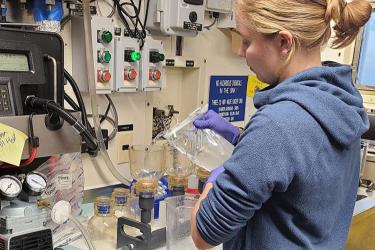What is your key responsibility?
My job as a Marine Mammal Specialist at NOAA Fisheries is to protect and conserve marine mammals. I am the recovery coordinator for the endangered Western Distinct Population Segment of Steller sea lions in Alaska. I am also the coordinator of the international Pinniped Entanglement Group and the Alaska Regional Coordinator of NOAA’s Ocean Guardian School Program. I work on finding effective ways to prevent negative human-marine mammal interactions. I’m doing my best to also create new outreach and education to bring more awareness to the plight of marine mammals.
Where did you grow up?
I was born in Ohio but moved to El Segundo, California when I was 3 years old so I pretty much grew up there. We lived just a few blocks from the beach so I spent much of my childhood in the ocean. I love swimming and always seemed to be in the pool or in the ocean as a kid. We moved back to Ohio when I was starting tenth grade, so I finished high school in Ohio, then moved back to northern California to go to university.
What is your educational background?
I got my B.S. degree in Wildlife Management, with minors in biology and English, from Humboldt State University in Arcata, California. I then got my M.S. degree in Marine Science from Moss Landing Marine Laboratories (part of the California State University system), in Monterey Bay, California.
Are you a member of a notable community organization, church, or volunteer/mentorship program?
Work, my family, and my animals take up most of my time, but I volunteer as much as possible. I have volunteered for many different events for young women in science, outreach events at schools to teach kids about the impacts of marine debris on marine mammals (I even designed a marine debris obstacle course), and K-12 science fairs. I have given many presentations to the community about Steller sea lions, potential solutions to reduce marine debris and entanglement risk, and to bring awareness about the amazing Ocean Guardian School Program.
What do you like to do outside of work?
My favorite thing to do when I am not at work is to be outside. I love spending time with my husband and son, hiking with our dogs, riding bikes, and exploring Southeast Alaska by boat. I also love to travel.
Is there a book, quote, or person that influenced you to be the person that you are today? Tell us why.
Both of my parents had a major influence on me, but since it is Women’s History Month, I would like to highlight my mom. My mom inspired me in many ways. She taught me at a young age that I could do anything a boy could do. She was my Girl Scout leader for many years and encouraged me to stay in Girl Scouts until I became a “First Class Girl Scout,” which is the equivalent to an Eagle Scout. My mom taught me the importance that all life was valuable. I remember many evenings when we would come home and I would get out of the car and move all of the snails off of the driveway so we would not run them over. During my childhood, we took in many stray animals, so helping animals was a huge part of my life and that continues to this day. It is really important to me to do my best to help protect this earth and the animals that live here.
What does Women's History Month mean to you?
Women’s History Month is a great opportunity to highlight all of the amazing careers available to women and to inspire the next generation of women to let them know that they can do anything that they put their minds to.
What advice would you have for someone interested in a career at NOAA Fisheries?
My advice is to always follow your passion. Please never let anyone else hold you back. If you want something bad enough, keep trying, find a positive direction through the difficult times, help others (not just yourself) and you will achieve your dream. I remember back in graduate school, a lot of my fellow students that really wanted to work with marine mammals gave up because they said “there are no jobs.” I said “someone has to have those jobs and there is no reason that it cannot be me.” And that is true.
NOAA has so many great opportunities for someone interested in a career that focuses on the ocean. If you are still young, you could try to job shadow someone at NOAA to get a better understanding of their day to day job. Keep learning! In our modern world, there is so much information available at your fingertips. Get as much experience as you can in your field of interest. And be yourself. A diverse workforce is the most amazing workforce because many different perspectives can bring great rewards. You can get there!





